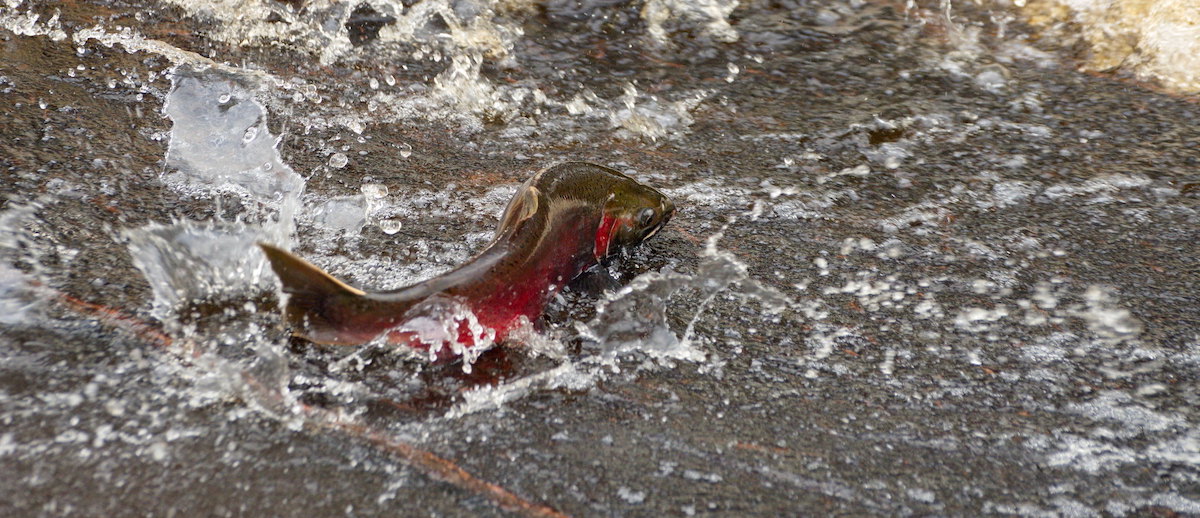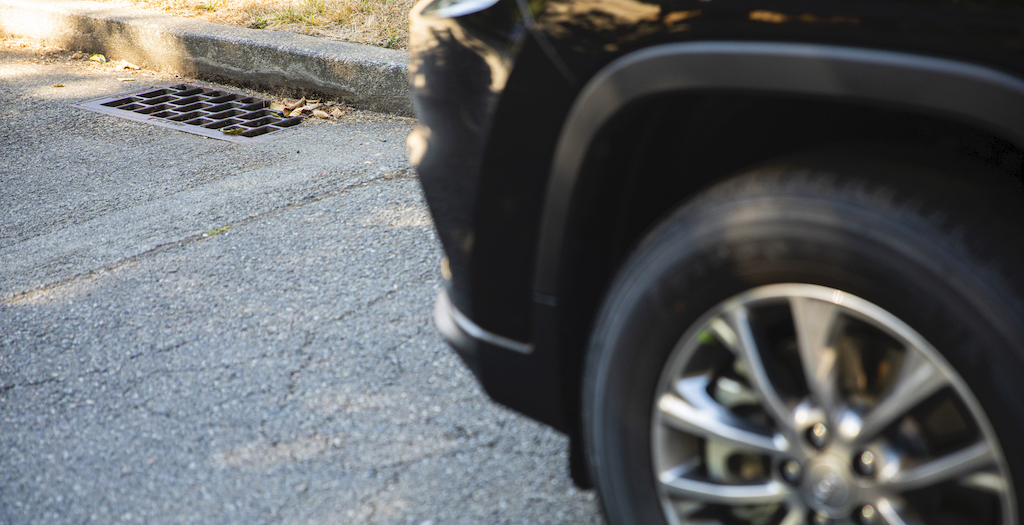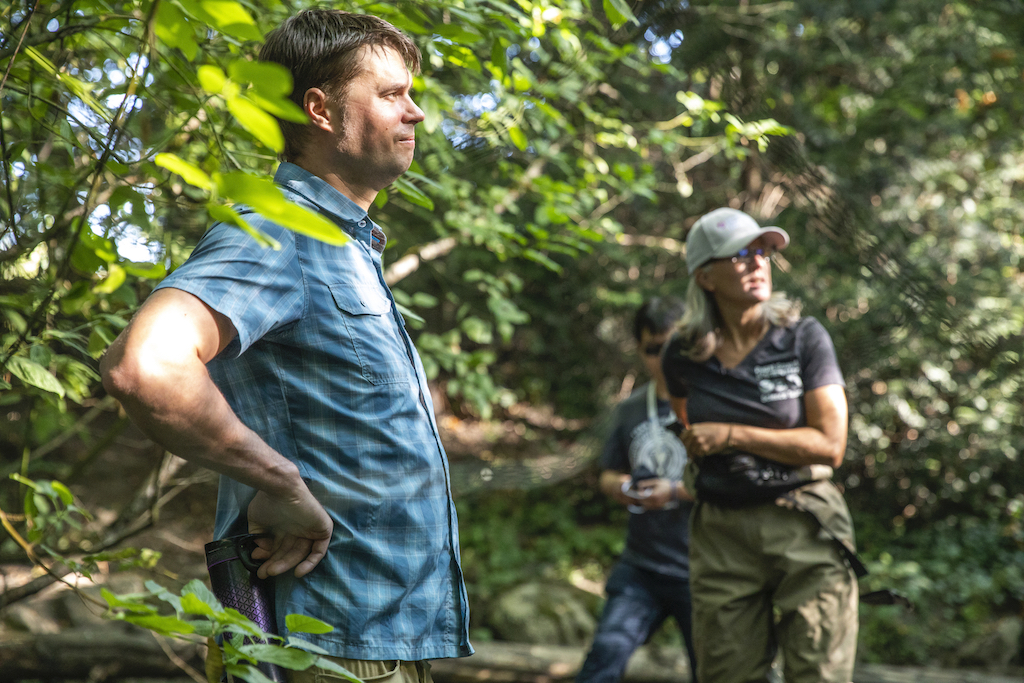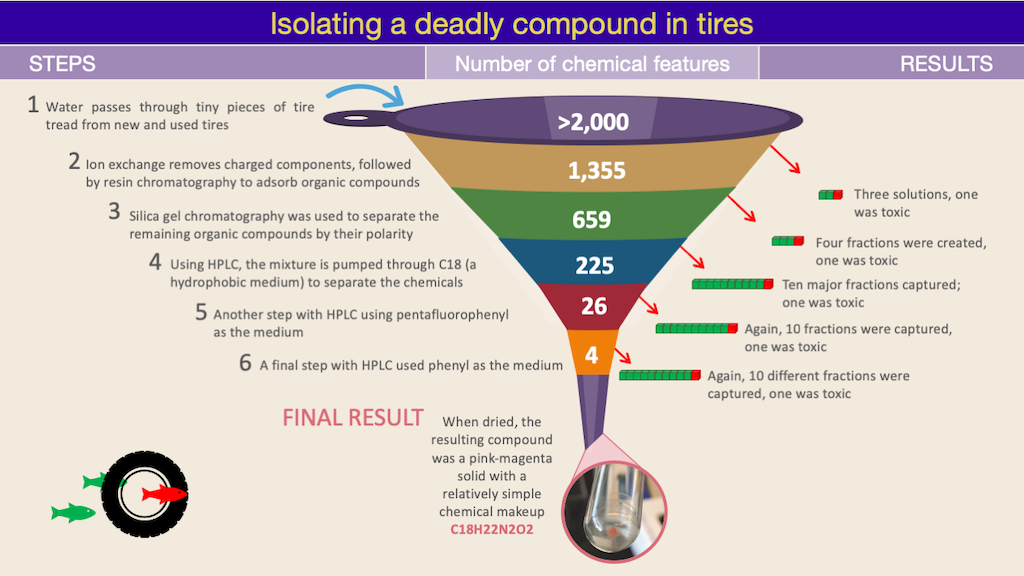By 2018, researchers at the Center for Urban Waters had conducted a series of experiments comparing chemicals in stormwater to those found in fish tissues. The focus shifted to tires when researchers discovered that a solution made from ground-up tire treads was chemically similar to components in toxic stormwater.
The next step would be an extraordinary challenge: Chemists would seek to separate the deadly chemical or chemicals, still a complete mystery, from an untold number of other compounds found in tires.
This approach is called non-target analysis, because one makes no assumptions about the chemicals that might be found. Traditional methods involved testing for individual chemicals, typically from a long list of known toxicants. But the tried-and-true approach would not work if the chemical were truly unknown.
At each step in the process, separated solutions are tested for toxicity. Those found to be toxic undergo further separation and testing in a process called “effect-directed analysis.” Eventually only one or a few chemicals remain.
Unraveling the mystery
Zhenyu Tian, who was hired by Kolodziej in 2017, had the right skills, ingenuity and perseverance to move the project to completion, though it would take 2 1/2 years of strenuous work, as Kolodziej described it.
As a graduate student at the University of North Carolina at Chapel Hill, Tian had used the non-target approach to analyze soils at a toxic-waste site before and after they underwent biological treatment. He was able to isolate and identify unusual toxic compounds produced during the bioremediation of hydrocarbons, which had triggered cleanup at the site.
At the Center for Urban Waters, Tian tackled the project with gusto, motivated by the knowledge that coho salmon were still dying in the streams while researchers sought out a cause.
For Tian, taking the job in Washington meant a temporary long-distance relationship with his wife, who had taken a good job in New York City. What followed was a lot of phone conversations, online video calls and an occasional rendezvous in distant cities before the pandemic. Being apart also meant that Tian would have few distractions from his work.
“I felt I needed to get this done, and I believed I was the best person to do it,” he said.
The chemical brew used for the analysis came from running water through a mixture of ground-up rubber from nine different kinds of tires, some old and some new. For these experiments, tiny juvenile coho were exposed to test the toxicity after each step of separation.
The original toxic mixture contained more than 2,200 chemical “features,” a term used in mass spectrometry to mean chemicals and their fragments. Through separation techniques, using different methods over and over in trial-and-error fashion, the toxic fraction was narrowed to 1,355 features, then to 659, 225, 24 and then just four. From the final four, the chemical formula of the toxic compound was found to be C18H22N2O2.
Searching in references from tire manufacturers, Tian could find no mention of such a chemical used to make tires. After all this work over two years, was the mystery to remain unsolved?
“This was a question that kept me up at night,” Tian said. “I kept wondering what it could be. Then suddenly, one morning last December, I had a thought go through my mind: This was probably a transformation product!”
He went back to the list of tire chemicals and found a chemical formula similar to the one he had derived, but it had two extra hydrogen atoms and no oxygen atoms. The exchange of hydrogen for oxygen in one of the tire chemicals had transformed it into the toxic compound that had remained a mystery for so long.
“It was kind of like magic,” Tian said. “I knew this had to be the parent chemical.”
The parent chemical, called 6-PPD, is used in rubber formulations to reduce the damage from ozone, which is related to automobile exhaust. In fact, 6-PPD sucked up ozone (a form of oxygen) so well that it turned into the highly toxic transformation product, 6-PPD-quinone.
While the toxicity of 6-PPD has been reported, it appears that 6-PPD-quinone has not been studied, Tian said. In fact, the limited references that he found had misidentified the transformation product as a chemical with a different molecular structure.
To verify the laboratory identification, the research team purchased 6-PPD from an industrial supplier and converted it to 6-PPD-quinone. Effects were measured on coho exposed to the pure compound at various concentrations to produce a standard dose-response curve. Toxic effects from the commercially derived product were consistent with what had been seen with tire leachate and roadway runoff.
To evaluate environmental effects, concentrations of 6-PPD-quinone were measured in samples of roadway runoff collected from various locations in and around Seattle and Los Angeles. Based on the dose-response curve, the researchers concluded that every sample of runoff, as it washes off the roads, contained enough 6-PPD-quinone to kill every coho that comes into contact with it. That’s exactly what had been observed for years in the urban streams of Puget Sound.






